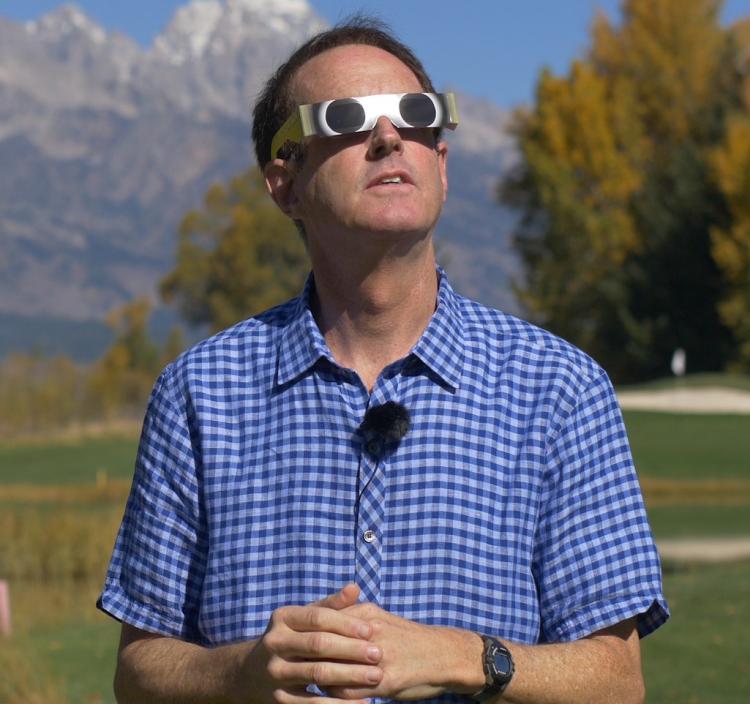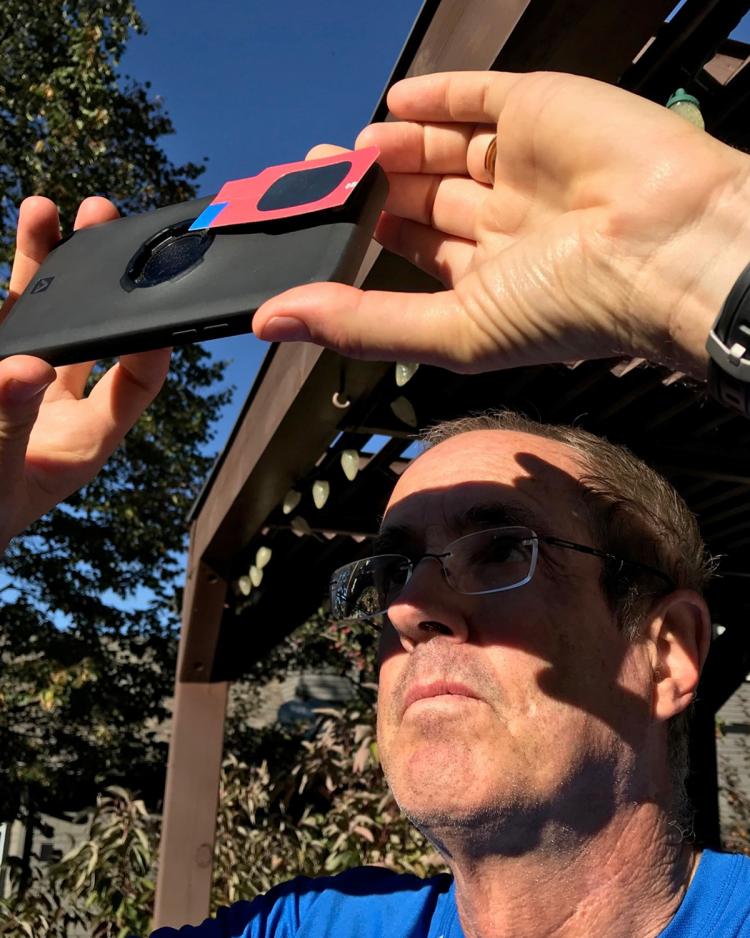Taking solar eclipse photos is a snap with gizmo astronomer developed
Doug Duncan, former director of CU Boulder’s Fiske Planetarium, developed the Solar Snap with today’s smartphone cameras in mind
More than 50 years later, Doug Duncan still vividly recalls seeing his very first solar eclipse.
“I saw my first eclipse on March 7, 1970. I can still tell you that it lasted for three minutes and 20 seconds, and it was the most awe-inspiring thing I had ever seen,” he says. “And I told myself then that I’ve got to see more of these—and so I’ve chased them all over the world since then and I’ve seen 12 of them so far.”
A solar eclipse—which occurs when the moon passes between the earth and the sun, thereby obscuring the view of the sun from a portion of the earth—is a sight to behold: The sky darkens and the unearthly silver streamers of the sun’s corona stretch across the sky, while pink “flames” decorate the sun’s edge.
“When there is a total eclipse of the sun, it’s just so intense—it’s unbelievably beautiful and strange. Some people viewing them will cheer while others will let out a scream or cry,” says Duncan, emeritus faculty member in the Department of Astrophysical and Planetary Sciences at the University of Colorado Boulder and the director of Fiske Planetarium from 2002 to 2018.

Top of page: Lunar eclipse photo composite captured by iPhone with Doug Duncan's invention, the Solar Snap. Above: Doug Duncan wearing eclipse glasses to safely watch the solar eclipse.
In recent years, Duncan has enjoyed taking large groups of people on trips across the country to witness solar eclipses and to experience the northern lights, when waves of color illuminate the night’s sky.
“Two things are stunningly more beautiful and even soul-inspiring in nature than anything else—and those two things are a total eclipse of the sun and the northern lights—and I have been privileged to experience both of them quite a bit,” he says. “And I’ve been fortunate to share those experiences with many others.”
Still, one thing Duncan noticed in recent years when taking groups of people to view solar eclipses is that many of them reached for their smartphones attempting to capture the event.
“At the last couple of eclipses, I noticed how much people love their phones and how they like taking pictures and posting them online for friends to see. So, I saw lots of people trying to take pictures of the sun and failing,” he says.
“That’s because your phone has a pretty nice camera, but the software in it is optimized for taking pictures of people and maybe landscapes—but certainly not for taking photos of a round orange dot against a black background.”
In fact, attempting to take photos of an eclipse with a standard smartphone camera can cause irreparable damage to the camera—just as looking directly at the sun for extended periods can cause permanent eye damage in people, according to Duncan.
“I’m not sure if everyone realizes it, but if you take your camera and pointed it at the sun and took photos for even a matter of several seconds, you’re going to ruin your camera,” he says. “Of course, the reason is the same for cameras as it is for your eyes—the sun is just so powerful. Staring at the sun would ruin your eyes—it would burn your retinas.”
To assist his fellow eclipse watchers, Duncan says he searched online extensively for something that would allow them to safely use their cameras but came up empty-handed. So, he decided he would have to invent something himself.
Necessity is the mother of invention
The first part of Duncan’s solution was straightforward: He took a pair of paper eclipse-viewing glasses, cut the glasses in half and trimmed off the temple, and attached a piece of Velcro to the viewing lens and a corresponding piece to his smartphone’s camera lens.
“I started taking photos of the sun, and I found I could take quite nice photos—but I had to completely override the adjustments on the camera,” Duncan says. “For instance, there are some apps that can make your smartphone camera behave more like a single-lens-reflex camera, where you adjust the shutter speed and the like. And I thought: you know, what’s really needed is an app where you can control the basic camera functions, and the three important ones in this case are: zoom, exposure and focus. Your camera automatically focuses on faces, so I wondered if I could get the camera to instead focus on the sun.”
He says he realized pretty quickly that for that kind of expertise he needed to find a professional programmer with experience writing software for smartphones. After securing one, Duncan says the two men spent about six months developing an app.
With a workable model in hand, Duncan field tested it in December 2020 during a partial eclipse viewable in Maine.

Doug Duncan using his invention, the Solar Snap with iPhone.
“I hopped on a plane and went to Maine. I sat in the driveway of some farmer’s house and took pictures of the partial eclipse, and it worked great,” he says.
Duncan next recruited 100 people to beta test the special smartphone lenses and software over a period of weeks and incorporated some useful suggestions into a final product, which he dubbed the Solar Snap. His beta testers were universally impressed with how easy the lens and software app were to use, he adds.
To mass produce the special eclipse-viewing lenses for smartphones, Duncan teamed up with Bartlett, Tennessee-based American Paper Optics, which he says is one of only two U.S.-based companies that make paper glasses for viewing solar eclipses and which has produced hundreds of thousands of such glasses through the years, according to the company’s website.
“American Paper Products was wonderful to work with in the development process. They have a guy who does their graphics, and he made the Solar Snap look great and the packaging look really snappy. Solar Snap is now finished and on the market, and I’m really pleased.”
Duncan says the Solar Snap is sold as a kit that includes two sets of special eclipse-viewing lenses for smartphones, two sets of paper eclipse-viewing glasses and instructions for downloading the software to make two cameras capable of taking eclipse photos.
American Paper Optics is selling the Solar Snap kits on its website and has agreements with major retailers to sell the company’s many products, according to Duncan.
The timing for the development of the Solar Snap seems fortuitus, given that the next partial eclipse in North America will happen on Oct. 13, and the next full solar eclipse in North America will occur April 8, 2024.
Perhaps not surprisingly, Duncan already has a group trip planned to Texas for the full eclipse, which he is calling “Totality Over Texas.”
Says Duncan, “I think people will want to check out the partial eclipse this year and the really big one next year, because the next total eclipse after that in North America is not until 2045.”

